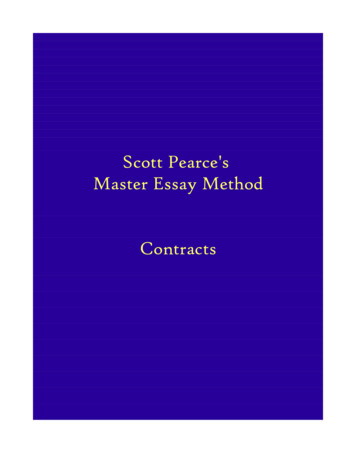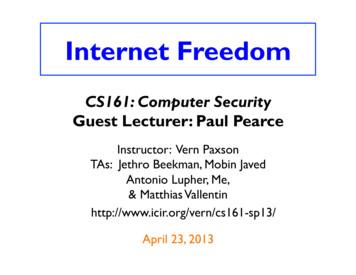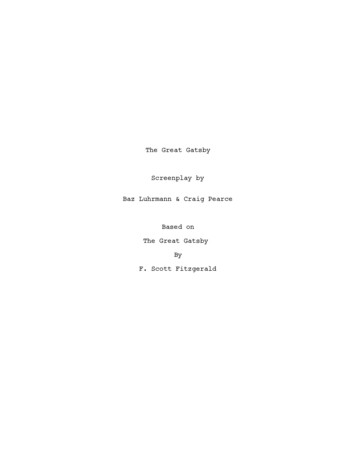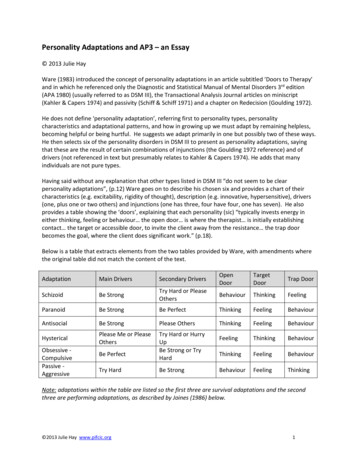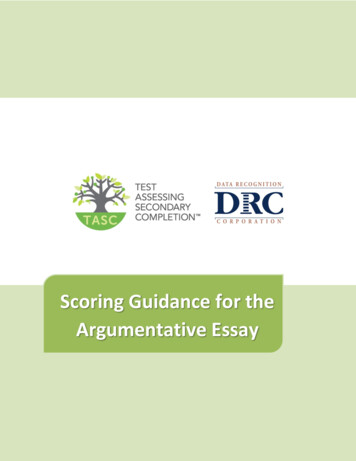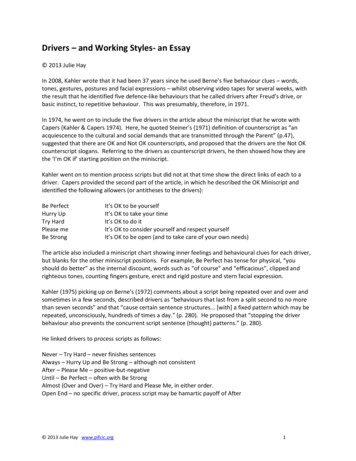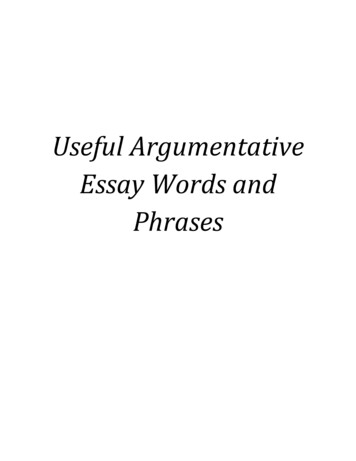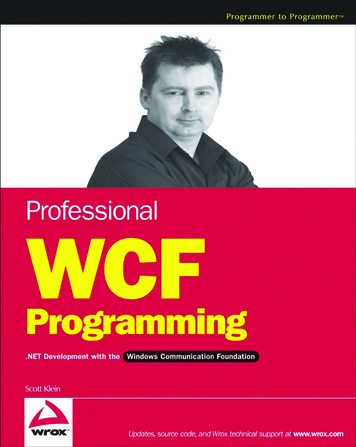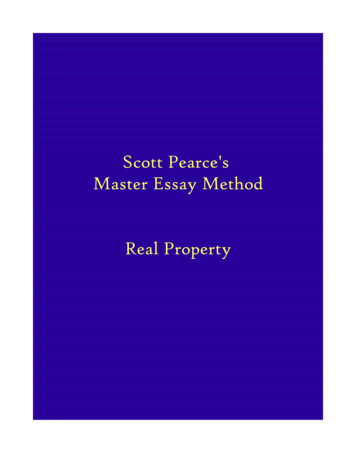
Transcription
Scott Pearce'sMaster Essay MethodReal Property
REAL PROPERTY APPROACHMinimalist ApproachI.Land OwnershipII.Land UseIII.Landlord TenantIV.RemediesElaborate ApproachI.Land OwnershipA.Adverse Possession1.2.3.B.Mental ElementPhysical ElementTime ElementEstates and Future Interests1.2.3.4.5.Fee Simple Absolute: Total ownership and no future interestFee Simple Determinable: Possibility of ReverterFee Simple Subject to a Condition Subsequent: Right of Re-entryFee Simple Subject to an Executory Interesta.Shifting - between granteesb.Springing - from grantee back to grantor then to new granteeLife Estate: Connected to Reversion or RemainderScott Pearce’s Master Essay Method - Real Property Approach
C.Concurrent Ownership (community property crossover)1.2.3.D.Land Sale Contracts and Mortgages (contracts crossover)E.Deeds and Conveyances12.3.F.Deed FormalitiesRecording ActsEquitable ConversionPossessory Rights Related to Land (torts crossover)1.2.3.II.Joint Tenancy: Each tenant has an undivided interest in the whole.Tenancy by the Entirety: Joint Tenancy by a married couple.Tenancy in Common: Each owner has a separate share.Water RightsLateral and Subjacent SupportWaste, Nuisance, TrespassLand UseA.Easements: Express, Implied, Prescriptive, EstoppelB.Licenses: Always revocable, except where executed or coupled with an interest.C.Covenants: Writing, Intent, Touch and Concern, Privity of EstateD.Servitudes - Legal and EquitableE.Land Use Regulations (Constitutional Law crossover - 5th Amendment taking)1.Zoning2.Police Power3.Eminent DomainScott Pearce’s Master Essay Method - Real Property Approach
III.Landlord-Tenant (contracts crossover)A.Types of Tenancies1.2.3.4.B.Condition of the Property (torts crossover)1.2.C.IV.Tenancy for Years - Fixed TermPeriodic Tenancy - Automatic Renewal, Notice to TerminateTenancy at Will - Either side can terminate without notice.Tenancy at Sufferance - Holdover tenant in possessionWasteFixturesAssignment and SubleaseRemediesA.DamagesB.RestitutionC.Equitable Relief1.2.D.Specific Performance of ContractsTemporary and Permanent InjunctionsDefenses to RemediesScott Pearce’s Master Essay Method - Real Property Approach
Real PropertyCopyright July, 2008 – State Bar of CaliforniaAnn, Betty, and Celia purchased a 3-bedroom condominium unit in which they resided. Each paid onethird of the purchase price. They took title as “joint tenants, with right of survivorship.”After a dispute, Betty moved out. Ann and Celia then each executed a separate deed by which eachconveyed her respective interest in the condominium unit to Ed. Each deed recited that the conveyancewas “in fee, reserving a life estate to the grantor.” Ann recorded her deed and delivered the originaldeed to Ed. Celia also recorded her deed and left the original deed with Ann in a sealed envelope withwritten instructions: “This envelope contains papers that are to be delivered to me on demand or in theevent of my death then to be delivered to Ed.” Celia recorded the deed solely to protect her life estateinterest. Ann, without Celia’s knowledge or authorization, mailed a copy of Celia’s deed to Ed.Subsequently, Ann and Celia were killed in a car accident. Betty then moved back into thecondominium unit. She rented out one bedroom to a tenant and used the other bedroom to run acomputer business. Betty paid all costs of necessary repairs to maintain the unit.Ed commenced an action against Betty, demanding a share of the rent she has collected. He alsodemanded that she pay rent for her use of the premises.Betty cross-complained against Ed, demanding that he contribute for his share of the costs of necessaryrepairs to maintain the unit.1.What are the property interests of Betty and Ed, if any, in the condominium unit? Discuss.2.What relief, if any, may Ed obtain on his claims against Betty for past due rent for her use of thecondominium unit and for a share of the rent paid by the tenant? Discuss.3.What relief, if any, may Betty obtain on her claim against Ed for contribution for the costs ofmaintaining the condominium unit? Discuss.Scott Pearce's Master Essay Method - July 2008 - Real Property
Real Property – Outline of IssuesCopyright 2008 – Scott F. Pearce, Esq.I.II.III.Property Interests of Betty and EdA.Ann, Betty and Celia buy the condo as joint tenantsB.Betty moves out: no severanceC.Ann's deed to EdD.Celia's deed to EdE.Ann and Celia dieF.Betty retakes possession of the condoG.Conclusion: Ed has 2/3, Betty 1/3 as tenants in commonEd v. BettyA.Past due rent from BettyB.Share of rent from tenantC.Conclusion: Ed gets 2/3 of rental incomeBetty v. Ed: probably no recoveryScott Pearce's Master Essay Method - July 2008 - Real Property
Real Property – AnswerCopyright 2008 – Scott F. Pearce, Esq.I.Property Interests of Betty and EdTo determine the property interests of Betty and Ed in the condominium, it is necessary to examine thechain of title.A.Ann, Betty and Celia buy the condo as joint tenantsA joint tenancy is a form of co-ownership in which each party has an undivided ownership interest andan equal right to occupy the property. When one tenant dies, the survivors take an equal interest in thedecedent's former share. Ann, Betty and Celia bought the condo in which they lived. They took title as"joint tenants with right of survivorship." In this case, the language in the title shows that Ann, Bettyand Celia intended to enter into a joint tenancy. Unities of time, title, interest and possession arepresent. The three women took the same title at the same time. They had the same interest and theirpossession was equal. Each had her own bedroom and each paid one-third of the purchase price.B.Betty moves out: no severanceBetty moved out after a dispute. This does not serve to sever the joint tenancy relationship betweenAnn, Betty and Celia. Although Betty abandoned her right to possess, she did not waive itpermanently, as evidenced by her later reoccupation of the premises. No facts are present to suggestthat Betty intended to make a gift of her share of the joint tenancy to Ann and Carla, the people she wasangry with.C.Ann's deed to EdAnn and Celia each executed a separate deed by which each conveyed her respective interest in thecondominium to Ed, each reserving to herself a life estate. To be valid, a conveyance must include adeed, delivery and title. In this case, Ann had good title. She recorded her deed to Ed and delivered theoriginal deed to Ed. Ann's deed to Ed (and Celia's, as discussed below) severs the joint tenancybecause it breaks the unity of interest. Ann's deed renders Ed a tenant in common, and it gives Ed aremainder in Ann's one-third interest.D.Celia's deed to EdCelia also had good title to her one-third interest. She recorded her deed, but only to protect her lifeestate interest. She did not physically deliver the original to Ed. Instead, she gave Ann the originalwith a note to give it back to Ann if she asked for it or to give it to Ed upon her death. Fortunately forEd, Celia's recording of the deed protects his remainder interest as well as Celia's life estate. Recordingthe deed will be deemed a constructive delivery to Ed.The result of the transaction between Ann, Celia and Ed is that Ed has a remainder interest in Ann andScott Pearce's Master Essay Method - July 2008 - Real Property
Celia's shares of the condo. The earlier joint tenancy between Ann, Celia and Betty is severed.E.Ann and Celia dieAnn and Celia were killed in a car accident after their conveyances to Ed. Their life estates ended atthe time of their deaths. Ed's remainder interest matured into a present possessory interest as a twothirds tenant in common with Betty.F.Betty retakes possession of the condoBetty moved back into the condo after Ann and Celia died. Betty occupied two bedrooms and rentedout the third to a tenant. As discussed above, Betty's previous departure did not terminate herownership interest in the property. Betty was acting within her rights to retake possession of thecondominium. Her liability to Ed is discussed below.G.ConclusionEd has a two-thirds interest and Betty has one-third as tenants in common.II.Ed v. BettyEd and Betty are tenants in common, with Ed owning two-thirds and Betty one-third. Ed sued Betty,demanding past-due rent from Betty and a share of the rent she has collected from tenant.A.Past due rent from BettyBetty was within her rights to reoccupy the condominium after Ann and Celia died. Although it isapparent that Betty and the tenant occupied all three bedrooms - one for Ann, one for her business andone for the tenant - no facts are present which suggest that the Ed ever tried to possess the propertyhimself. He was not ousted from the condo. Betty, as a tenant in common, does not owe rent to herfellow tenant in common rent for her occupation of the property. Certainly Ed would be within hisrights to occupy the second bedroom, forcing Betty to move her computer business somewhere else.Ed and Betty might make a deal in which she would pay rent to continue occupying the secondbedroom in the future, but Betty is not liable to Ed for her previous occupation.B.Share of rent from tenantTenants in common are entitled to a pro-rata share of income from the property. In this case, Betty ismaking money from renting out one of the bedrooms in the condo. She only owns a one-third interestin the unit. She must give up two-thirds of the rental income to Ed.C.ConclusionEd is not entitled to rent from Betty. He is entitled to claim two-thirds of the rental income.Scott Pearce's Master Essay Method - July 2008 - Real Property
III.Betty v. EdBetty paid all costs of necessary repairs to maintain the condo. Betty cross-complained against Ed,seeking contribution for his share of the costs of maintaining the condominium. As the occupyingtenant, Betty is responsible for these expenses at common law. If Betty were occupying the propertyby herself, she certainly would not be entitled to recover from Ed.Betty's claim is strengthened by Ed's demand for two-thirds of the rent from the tenant. As discussedabove, Ed has a right to demand his share of the rental income. Under these circumstances, it would beunfair for Betty to be solely responsible for maintaining the premises. It is possible that Ed's recoveryof his share of the rent will be reduced to reflect Ed's share of the costs of maintaining the tenant'sleasehold.Scott Pearce's Master Essay Method - July 2008 - Real Property
Real PropertyCopyright July, 2007 – State Bar of CaliforniaLarry leased in writing to Tanya a four-room office suite at a rent of 500 payable monthly in advance.The lease commenced on July 1, 2006. The lease required Larry to provide essential services toTanya's suite. The suite was located on the 12th floor of a new 20-story office building.In November Larry failed to provide essential services to Tanya's suite on several occasions. Elevatorservice and running water were interrupted once; heating was interrupted twice; and electrical servicewas interrupted on three occasions. These services were interrupted for periods of time lasting fromone day to one week. On December 5, the heat, electrical and running water services were interruptedand not restored until December 12. In each instance Tanya immediately complained to Larry, whotold Tanya that he was aware of the problems and was doing all he could to repair them.On December 12, Tanya orally told Larry that she was terminating her lease on February 28, 2007because the constant interruptions of services made it impossible for her to conduct her business. Shepicked the February 28 termination date to give herself ample opportunity to locate alternative officespace.Tanya vacated the suite on February 28 even though between December 12 and February 28 there wereno longer any problems with the leased premises.Larry did not attempt to relet Tanya's vacant suite until April 15. He found a tenant to lease the suitecommencing on May 1 at a rent of 500 payable monthly in advance. On May 1, Larry brought suitagainst Tanya to recover rent for the months of March and April.On what theory could Larry reasonably assert a claim to recover rent from Tanya for March and Apriland what defenses could Tanya reasonably assert against Larry's claim for rent? Discuss.Scott Pearce's Master Essay Method – Real Property – July 2007
Real Property – Outline of IssuesCopyright 2007 – Scott F. Pearce, Esq.I.II.Larry's Theory of Liability Arises out of the Real Property Landlord-Tenant LawA.The Lease Between Larry and TanyaB.Tanya's Breach1.Tanya's Oral Termination2.Tanya's Failure to Pay RentC.DamagesD.ConclusionTanya's Defenses Against Larry's Claim for RentA.Covenant of Quiet EnjoymentB.Partial Eviction / Constructive EvictionC.Warranty of HabitabilityD.Larry's Failure to Mitigate DamagesE.Damages Suffered by TanyaF.ConclusionScott Pearce's Master Essay Method – Real Property – July 2007
REAL PROPERTYCopyright February, 2007 – State Bar of CaliforniaBuilder sold a shopping mall to Owner. The recorded deed from Builder to Owner conveyed the malland parking lot where the parking spaces were numbered 1 to 100. The deed reserved to Builder theexclusive right to use parking spaces 15 through 20 as a place to set up a stand to sell sportsmemorabilia and sandwiches on Sundays. The shopping mall was located adjacent to an existingresidential neighborhood.Owner entered into a written 30-year lease with Lois leasing to her a store in the mall and parkingspaces 1 through 20. Under the lease, Lois agreed to pay rent monthly and not to assign the leasewithout Owner’s prior written approval. After occupying the leased premises for five years, Loissubleased the store and parking spaces to Fast Food for a term of ten years without first havingobtained Owner’s written approval.Fast Food occupied the premises and paid rent to Owner. Fast Food, which operated a take-outrestaurant on the premises seven days a week, used state-of-the-art
D. Land Sale Contracts and Mortgages (contracts crossover) E. Deeds and Conveyances 1 Deed Formalities 2. Recording Acts 3. Equitable Conversion F. Possessory Rights Related to Land (torts crossover) 1. Water Rights 2. Lateral and Subjacent Support 3. Waste, Nuisance, Trespass II. Land Use A. Easements: Express, Implied, Prescriptive, Estoppel B. Licenses: Always revocable, except where .
